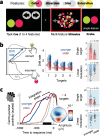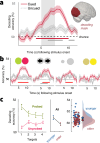Broadscale dampening of uncertainty adjustment in the aging brain
- PMID: 39715747
- PMCID: PMC11666723
- DOI: 10.1038/s41467-024-55416-2
Broadscale dampening of uncertainty adjustment in the aging brain
Abstract
The ability to prioritize among input features according to relevance enables adaptive behaviors across the human lifespan. However, relevance often remains ambiguous, and such uncertainty increases demands for dynamic control. While both cognitive stability and flexibility decline during healthy ageing, it is unknown whether aging alters how uncertainty impacts perception and decision-making, and if so, via which neural mechanisms. Here, we assess uncertainty adjustment across the adult lifespan (N = 100; cross-sectional) via behavioral modeling and a theoretically informed set of EEG-, fMRI-, and pupil-based signatures. On the group level, older adults show a broad dampening of uncertainty adjustment relative to younger adults. At the individual level, older individuals whose modulation more closely resembled that of younger adults also exhibit better maintenance of cognitive control. Our results highlight neural mechanisms whose maintenance plausibly enables flexible task-set, perception, and decision computations across the adult lifespan.
© 2024. The Author(s).
Conflict of interest statement
Competing interests: The authors declare no competing interests.
Figures







Similar articles
-
Aging Affects Dopaminergic Neural Mechanisms of Cognitive Flexibility.J Neurosci. 2016 Dec 14;36(50):12559-12569. doi: 10.1523/JNEUROSCI.0626-16.2016. Epub 2016 Nov 2. J Neurosci. 2016. PMID: 27807030 Free PMC article.
-
Task-Specific Neural Representations of Generalizable Metacognitive Control Signals in the Human Dorsal Anterior Cingulate Cortex.J Neurosci. 2022 Feb 16;42(7):1275-1291. doi: 10.1523/JNEUROSCI.1283-21.2021. Epub 2021 Dec 14. J Neurosci. 2022. PMID: 34907025 Free PMC article.
-
Aging and decision making under uncertainty: behavioral and neural evidence for the preservation of decision making in the absence of learning in old age.Neuroimage. 2010 Oct 1;52(4):1514-20. doi: 10.1016/j.neuroimage.2010.05.008. Epub 2010 May 18. Neuroimage. 2010. PMID: 20472072
-
Effects and mechanisms of information saliency in enhancing value-based decision-making in younger and older adults.Neurobiol Aging. 2021 Mar;99:86-98. doi: 10.1016/j.neurobiolaging.2020.11.018. Epub 2020 Dec 11. Neurobiol Aging. 2021. PMID: 33422897
-
Cognitive neuroscience of aging: contributions of functional neuroimaging.Scand J Psychol. 2001 Jul;42(3):277-86. doi: 10.1111/1467-9450.00237. Scand J Psychol. 2001. PMID: 11501741 Review.
References
-
- Desimone, R. & Duncan, J. Neural mechanisms of selective visual-attention. Annu. Rev. Neurosci.18, 193–222 (1995). - PubMed
-
- Findling, C., Skvortsova, V., Dromnelle, R., Palminteri, S. & Wyart, V. Computational noise in reward-guided learning drives behavioral variability in volatile environments. Nat. Neurosci.22, 2066–2077 (2019). - PubMed
-
- Pulcu, E. & Browning, M. The misestimation of uncertainty in affective disorders. Trends Cognit. Sci.23, 865–875 (2019). - PubMed
MeSH terms
LinkOut - more resources
Full Text Sources
Medical

